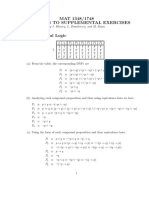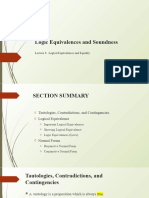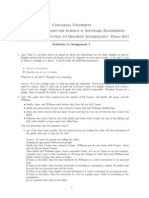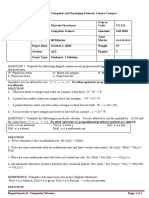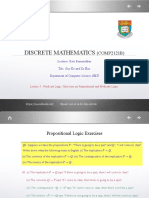COMP9414: Artificial Intelligence - Solutions Week 5 Propositional Logic
Uploaded by
Hồ Nguyễn Quang DuyCOMP9414: Artificial Intelligence - Solutions Week 5 Propositional Logic
Uploaded by
Hồ Nguyễn Quang DuyCOMP9414: Articial Intelligence - Solutions Week 5 Propositional Logic
1. (i) (Ja Jo) T Where: Ja: Jane is in town Jo: John is in town T : we will play tennis (ii) R R Where: R: it will rain today (iii) S P Where: S: you study P : you will pass this course (i) P Q P Q (remove ) (ii) (P Q) R (P Q) R (remove ) (P Q) R (De Morgan) (P Q) R (Double Negation) (P R) (Q R) (Distribute over ) (iii) (P Q) (R Q) (P Q) (R Q) (remove ) (P Q) (R Q) (Double Negation) (P R Q) (Q R Q) (Distribute over ) This can be further simplied to: (P R Q) (Q R) And in fact this can be simplied to Q R since Q R P R Q
2.
P Q P Q Q P T T T F F 3. (i) T F F T F F T T F T F F T T T In all rows where both P Q and Q are true, P is also true. Therefore, inference is valid. P Q P Q P Q Q P T T F F T T (ii) T F F T F F F T T F T T F F T T T T In all rows where both P Q is true, Q P is also true. Therefore, inference is valid. P Q R P Q QR P R T T T T T T T T F T F F T F T F T T (iii) T F F F T F F T T T T T F T F T F T F F T T T T F F F T T T
In all rows where both P Q and Q R are true, P R is also true. Therefore, inference is valid. 4. (i) CNF(P Q) P Q CNF(Q) Q CNF(P ) P (Double Negation) Proof: 1. P Q 2. Q 3. P 4. Q 5. (ii) CNF(P Q) P Q CNF((Q P )) (Q P ) (Remove ) (Q P ) (Double Negation) Q P (De Morgan) Q P (Double Negation) Proof: 1. P Q 2. Q 3. P 4. P 5. (Hypothesis) (Negation of Conclusion) (Negation of Conclusion) 1, 2 Resolution 3, 4 Resolution (Hypothesis) (Hypothesis) (Negation of Conclusion) 1, 3 Resloution 2, 4 Resloution
(iii) P Q, Q R P R CNF(P Q) P Q CNF(Q R) Q R CNF((P R)) (P R) (Remove ) P R (De Morgan) P R (Double Negation) Proof: 1. P Q 2. Q R 3. P 4. R 5. Q 6. R 7. (Hypothesis) (Hypothesis) (Negation of Conclusion) (Negation of Conclusion) 1, 3 Resolution 2, 5 Resolution 4, 6 Resolution
5.
P Q P P Q (P Q) P ((P Q) P ) Q T T F T F T (i) T F F T F T F T T T T T F F T F F T Last column is always true no matter what truth assignment to P and Q. Therefore ((P Q) P ) Q is a tautology. (ii) S = ((P Q) (P R)) (P Q) P Q R P Q P R (P R) (P Q) (P R) S T T T T T F F T T T F T F T T T T F T F T F F T T F F F F T F T F T T T T F F T F T F T T F F T F F T T T F F T F F F T T F F T Last column is always true no matter what truth assignment to P , Q and R. Therefore ((P Q) (P R)) (P Q) is a tautology. (iii) P T F Last P P P (P P ) (P P ) P F F T T T F T F column is not always true. Therefore (P P ) P is not a tautology.
(iv) (P Q) (P Q) P Q P Q P Q P Q (P Q) (P Q) (P Q) T T F F T F T T T F F T T F T T F T T F T F T T F F T T F T F T Last column is always true no matter what truth assignment to P and Q. Therefore (P Q) (P Q) is a tautology. 6. (i) CNF((((P Q) P ) Q)) (((P Q) P ) Q) (Remove ) ((P Q) P ) Q (De Morgan) (P Q) P Q (Double Negation) Proof: 1. P Q (Negated Conclusion) 2. P (Negated Conclusion) 3. Q (Negated Conclusion) 4. Q 1, 2 Resolution 5. 3, 4 Resolution Therefore (((P Q) P ) Q) is a tautology. (ii) CNF((((P Q) (P R)) (P Q))) (((P Q) (P R)) (P Q)) (Remove ) ((P Q) (P R)) (P Q) (De Morgan) (P Q) (P R) (P Q) (Double Negation and De Morgan) (P Q) (P R) (P Q) (Double Negation) Proof:
1. P Q (Negated Conclusion) 2. P (Negated Conclusion) 3. R (Negated Conclusion) 4. Q (Negated Conclusion) 5. Q 1, 2 Resolution 6. 4, 5 Resolution Therefore ((P Q) (P R)) (P Q) is a tautology. (iii) CNF(((P P ) P )) (P P ) P (De Morgan) (P P ) P (Double Negation) (P P ) (P P ) (Distribute over ) P (Can simplify to this by removing repetition and tautologies) Proof: 1. P (Negated Conclusion) Cannot obtain empty clause using resolution so (P P ) P is not a tautology. (iv) CNF(((P Q) (P Q))) ((P Q) (P Q)) (Remove ) (P Q) (P Q) (De Morgan) (P Q) P Q (Double Negation) Proof: 1. P Q 2. Q 3. P 4. P 5. Therefore (P (Negated Conclusion) (Negated Conclusion) (Negated Conclusion) 1, 2 Resolution 3, 4, Resolution Q) (P Q) is a tautology.
You might also like
- Book Solutions Discrete Mathematics and Its Applications Kenneth H Rosen61% (28)Book Solutions Discrete Mathematics and Its Applications Kenneth H Rosen37 pages
- Solutions Manual For A Transition To Advanced Mathematics 7th Edition by Smith Sample Chapter50% (2)Solutions Manual For A Transition To Advanced Mathematics 7th Edition by Smith Sample Chapter18 pages
- Deductive Reasoning Practice Test #2 V1.0-With AnswersNo ratings yetDeductive Reasoning Practice Test #2 V1.0-With Answers6 pages
- Lecture 3 - Logic Equivalences and SoundnessNo ratings yetLecture 3 - Logic Equivalences and Soundness25 pages
- Prove: (P Q) Q P Q: Proofs Using Logical EquivalencesNo ratings yetProve: (P Q) Q P Q: Proofs Using Logical Equivalences4 pages
- 02 PropLogicPrfs-DNFCombined - Handout PDFNo ratings yet02 PropLogicPrfs-DNFCombined - Handout PDF4 pages
- HW 1 Solutions: Compsci 102 Discrete Mathematics For Cs Spring 2006 ForbesNo ratings yetHW 1 Solutions: Compsci 102 Discrete Mathematics For Cs Spring 2006 Forbes6 pages
- Homework 8: Solutions - Math 110 INSTRUCTOR: George VoutsadakisNo ratings yetHomework 8: Solutions - Math 110 INSTRUCTOR: George Voutsadakis2 pages
- JEE Main Mathematical Reasoning Practice Paper With Solutions Download PDFNo ratings yetJEE Main Mathematical Reasoning Practice Paper With Solutions Download PDF7 pages
- Rules of Inference:: Any of The Following Logically Equivalent Expressions Can Replace Each Other Wherever They OccurNo ratings yetRules of Inference:: Any of The Following Logically Equivalent Expressions Can Replace Each Other Wherever They Occur3 pages
- CS2742 Midterm Test 1 Study Sheet Propositional LogicNo ratings yetCS2742 Midterm Test 1 Study Sheet Propositional Logic3 pages
- Computer Science & Engineering 235 - Discrete MathematicsNo ratings yetComputer Science & Engineering 235 - Discrete Mathematics2 pages
- w01 Tutorial Propositional Logic SolutionsNo ratings yetw01 Tutorial Propositional Logic Solutions7 pages
- CPT 317 - AI Week 7 PL FOL (Question and Answer)No ratings yetCPT 317 - AI Week 7 PL FOL (Question and Answer)9 pages
- Logical Equivalences: Tautology: Self Contradiction/ ContradictionNo ratings yetLogical Equivalences: Tautology: Self Contradiction/ Contradiction7 pages
- Ma3354 DM Unit 1 Part A, B Question and AnswerNo ratings yetMa3354 DM Unit 1 Part A, B Question and Answer9 pages
- Unit-3 - C - Resolution in Propositional Logic in DetailNo ratings yetUnit-3 - C - Resolution in Propositional Logic in Detail32 pages
- Assignment 1: Discrete Structure BS (CS) Propositional Logic 13th March 2022No ratings yetAssignment 1: Discrete Structure BS (CS) Propositional Logic 13th March 20221 page
- 10+2 Level Mathematics For All Exams GMAT, GRE, CAT, SAT, ACT, IIT JEE, WBJEE, ISI, CMI, RMO, INMO, KVPY Etc.From Everand10+2 Level Mathematics For All Exams GMAT, GRE, CAT, SAT, ACT, IIT JEE, WBJEE, ISI, CMI, RMO, INMO, KVPY Etc.No ratings yet
- Mathematical Reasoning Notes For JEE Main - pdf-36No ratings yetMathematical Reasoning Notes For JEE Main - pdf-364 pages
- Theory of Computer Science Automata Languages and Computation 3rd Edition K.L.P. Mishra - Quickly download the ebook to read anytime, anywhereNo ratings yetTheory of Computer Science Automata Languages and Computation 3rd Edition K.L.P. Mishra - Quickly download the ebook to read anytime, anywhere80 pages
- Propositional Model Checking using PythonNo ratings yetPropositional Model Checking using Python4 pages
- CSE 103: Discrete Mathematics Chapter 1.1.-1.3: Propositional LogicNo ratings yetCSE 103: Discrete Mathematics Chapter 1.1.-1.3: Propositional Logic20 pages
- (Oxford Logic Guides) Grzegorz Malinowski - Many-Valued Logics-Clarendon Press (1993)No ratings yet(Oxford Logic Guides) Grzegorz Malinowski - Many-Valued Logics-Clarendon Press (1993)139 pages
- Module 9: The Conditional and The Biconditional: Antecedent and The Q Statement Is Called The ConsequentNo ratings yetModule 9: The Conditional and The Biconditional: Antecedent and The Q Statement Is Called The Consequent4 pages
- 2.2. Rules of Inference and The Direct Proof of ValidityNo ratings yet2.2. Rules of Inference and The Direct Proof of Validity7 pages
- Sri Krishna Arts and Science Computer Technology: Course Coordinator Dr. V. S. Anita Sofia Prof. & Head100% (1)Sri Krishna Arts and Science Computer Technology: Course Coordinator Dr. V. S. Anita Sofia Prof. & Head20 pages
- Section 1.3: Valid and Invalid ArgumentsNo ratings yetSection 1.3: Valid and Invalid Arguments8 pages
- Book Solutions Discrete Mathematics and Its Applications Kenneth H RosenBook Solutions Discrete Mathematics and Its Applications Kenneth H Rosen
- Solutions Manual For A Transition To Advanced Mathematics 7th Edition by Smith Sample ChapterSolutions Manual For A Transition To Advanced Mathematics 7th Edition by Smith Sample Chapter
- Deductive Reasoning Practice Test #2 V1.0-With AnswersDeductive Reasoning Practice Test #2 V1.0-With Answers
- Prove: (P Q) Q P Q: Proofs Using Logical EquivalencesProve: (P Q) Q P Q: Proofs Using Logical Equivalences
- HW 1 Solutions: Compsci 102 Discrete Mathematics For Cs Spring 2006 ForbesHW 1 Solutions: Compsci 102 Discrete Mathematics For Cs Spring 2006 Forbes
- Homework 8: Solutions - Math 110 INSTRUCTOR: George VoutsadakisHomework 8: Solutions - Math 110 INSTRUCTOR: George Voutsadakis
- JEE Main Mathematical Reasoning Practice Paper With Solutions Download PDFJEE Main Mathematical Reasoning Practice Paper With Solutions Download PDF
- Rules of Inference:: Any of The Following Logically Equivalent Expressions Can Replace Each Other Wherever They OccurRules of Inference:: Any of The Following Logically Equivalent Expressions Can Replace Each Other Wherever They Occur
- CS2742 Midterm Test 1 Study Sheet Propositional LogicCS2742 Midterm Test 1 Study Sheet Propositional Logic
- Computer Science & Engineering 235 - Discrete MathematicsComputer Science & Engineering 235 - Discrete Mathematics
- Logical Equivalences: Tautology: Self Contradiction/ ContradictionLogical Equivalences: Tautology: Self Contradiction/ Contradiction
- Unit-3 - C - Resolution in Propositional Logic in DetailUnit-3 - C - Resolution in Propositional Logic in Detail
- Assignment 1: Discrete Structure BS (CS) Propositional Logic 13th March 2022Assignment 1: Discrete Structure BS (CS) Propositional Logic 13th March 2022
- 10+2 Level Mathematics For All Exams GMAT, GRE, CAT, SAT, ACT, IIT JEE, WBJEE, ISI, CMI, RMO, INMO, KVPY Etc.From Everand10+2 Level Mathematics For All Exams GMAT, GRE, CAT, SAT, ACT, IIT JEE, WBJEE, ISI, CMI, RMO, INMO, KVPY Etc.
- Mathematical Reasoning Notes For JEE Main - pdf-36Mathematical Reasoning Notes For JEE Main - pdf-36
- Theory of Computer Science Automata Languages and Computation 3rd Edition K.L.P. Mishra - Quickly download the ebook to read anytime, anywhereTheory of Computer Science Automata Languages and Computation 3rd Edition K.L.P. Mishra - Quickly download the ebook to read anytime, anywhere
- CSE 103: Discrete Mathematics Chapter 1.1.-1.3: Propositional LogicCSE 103: Discrete Mathematics Chapter 1.1.-1.3: Propositional Logic
- (Oxford Logic Guides) Grzegorz Malinowski - Many-Valued Logics-Clarendon Press (1993)(Oxford Logic Guides) Grzegorz Malinowski - Many-Valued Logics-Clarendon Press (1993)
- Module 9: The Conditional and The Biconditional: Antecedent and The Q Statement Is Called The ConsequentModule 9: The Conditional and The Biconditional: Antecedent and The Q Statement Is Called The Consequent
- 2.2. Rules of Inference and The Direct Proof of Validity2.2. Rules of Inference and The Direct Proof of Validity
- Sri Krishna Arts and Science Computer Technology: Course Coordinator Dr. V. S. Anita Sofia Prof. & HeadSri Krishna Arts and Science Computer Technology: Course Coordinator Dr. V. S. Anita Sofia Prof. & Head
